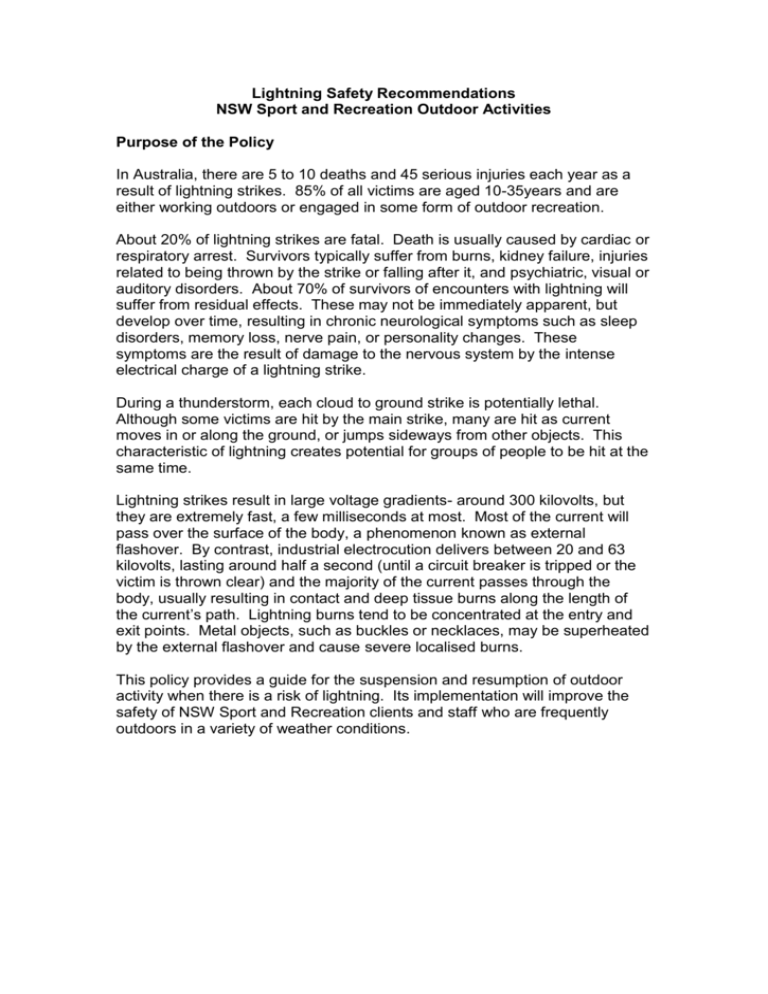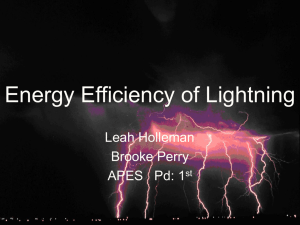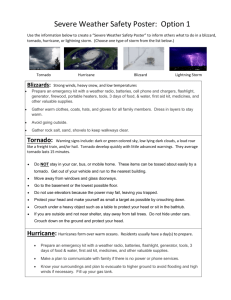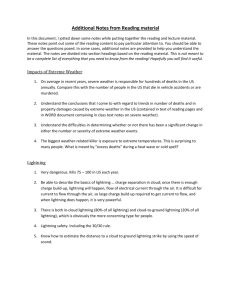Lightning Safety Recommendations NSW Sport
advertisement

Lightning Safety Recommendations NSW Sport and Recreation Outdoor Activities Purpose of the Policy In Australia, there are 5 to 10 deaths and 45 serious injuries each year as a result of lightning strikes. 85% of all victims are aged 10-35years and are either working outdoors or engaged in some form of outdoor recreation. About 20% of lightning strikes are fatal. Death is usually caused by cardiac or respiratory arrest. Survivors typically suffer from burns, kidney failure, injuries related to being thrown by the strike or falling after it, and psychiatric, visual or auditory disorders. About 70% of survivors of encounters with lightning will suffer from residual effects. These may not be immediately apparent, but develop over time, resulting in chronic neurological symptoms such as sleep disorders, memory loss, nerve pain, or personality changes. These symptoms are the result of damage to the nervous system by the intense electrical charge of a lightning strike. During a thunderstorm, each cloud to ground strike is potentially lethal. Although some victims are hit by the main strike, many are hit as current moves in or along the ground, or jumps sideways from other objects. This characteristic of lightning creates potential for groups of people to be hit at the same time. Lightning strikes result in large voltage gradients- around 300 kilovolts, but they are extremely fast, a few milliseconds at most. Most of the current will pass over the surface of the body, a phenomenon known as external flashover. By contrast, industrial electrocution delivers between 20 and 63 kilovolts, lasting around half a second (until a circuit breaker is tripped or the victim is thrown clear) and the majority of the current passes through the body, usually resulting in contact and deep tissue burns along the length of the current’s path. Lightning burns tend to be concentrated at the entry and exit points. Metal objects, such as buckles or necklaces, may be superheated by the external flashover and cause severe localised burns. This policy provides a guide for the suspension and resumption of outdoor activity when there is a risk of lightning. Its implementation will improve the safety of NSW Sport and Recreation clients and staff who are frequently outdoors in a variety of weather conditions. Key elements The key elements of the lightning safety policy are: 1. 2. 3. 4. 5. 6. 7. Proactive planning Monitoring of weather conditions Clear chain of command Communications Identification of safe structures Definition of criteria for suspension and resumption of activities First aid 1. Proactive planning Each location must be responsible for developing a locally suitable plan for the management of lightning risk. The plan should be documented and communicated to staff who work outdoors in such a manner that they are familiar with it and confident in its implementation. 2. Monitoring of weather conditions Where storms are forecast or seem likely, the day’s outdoor activities should be planned to minimize disruption where possible. It may be prudent to inform clients of the possibility of activities being disrupted due to lightning risk. Staff should be alert to changing weather conditions during the day and learn to recognize local weather patterns that indicate a high probability of thunderstorms. Many locations have access to weather radar through the Bureau of Meteorology website (www.bom.gov.au) which can be useful for monitoring approaching storm activity. 3. Clear chain of command Staff engaged in outdoor activities are responsible for monitoring the weather conditions around them. Program staff with responsibility for client groups should have the authority to make a safety call and cease activities or move to a safer location. This may sometimes require firm insistence that clients follow directions to move to safety. Where there is doubt about whether or not to continue with outdoor activities, the situation should be referred to the appropriate manager for a decision. 4. Communication There must be an established mechanism for communicating the decision to suspend outdoor activities. This should include clients, other staff who may be affected (eg a person operating machinery who may not hear the storm approaching) and management. Each location should have a procedure in place such that staff know where to take client groups and have alternate activities to offer until the all-clear is given. 5. Identification of safe structures No place is absolutely safe from lightning strikes, but some places are much safer than others. Each location must identify its safe areas and ensure that staff are aware of them. SAFER areas include: Enclosed vehicles with windows closed (car, bus, tractor with cab) Do not touch metal parts Substantial enclosed buildings Low ground, sheltering in clumps of low bushes Trees of uniform height- ie forest. UNSAFE areas include: High ground Open ground Water Isolated or tall trees Near outdoor metal structures such as fences, gates, poles, seating, ropes courses Insubstantial structures such as picnic sheds and shade shelters Machinery such as mowers or unenclosed tractors If you are caught outside during a storm and feel your hair stand on end or hear buzzing/crackling noise in the air, you are within the field of charge of a lightning strike. Remove metal objects (keys, badges, belts etc), crouch down with feet together, head down and hands over you ears. It is safer to adopt this position if outdoors than to be in one of the unsafe situations listed above. 6. Criteria for suspension and resumption of activities Lightning can strike more than 10km from the edge of a thunderstorm. It is generally agreed that 10km is the minimum safe distance from a storm. The 30/30 rule is used to serve as a guide for the suspension and safe resumption of activities. The first part of the 30/30 rule is determined by counting the seconds from when the lightning flash was seen to when the thunder is heard. Sound travels at about 1 kilometre every 3 seconds, so a 30 second interval means the storm is 10km away. Staff should be monitoring the storm’s approach and as the flash to bang count nears 30 seconds, people at risk should already be seeking safe shelter. A “flash to bang” count of 30 seconds or less requires immediate and urgent evacuation to safety. The second part of the 30/30 rule provides the criteria for resuming activities. It is recommended that the storm be 20km away before it is considered safe. A typical storm moves at 40km/h, so waiting 30 minutes after the last thunder is heard or lightning seen provides the 20km safe distance. It is important to emphasize that blue sky and the absence of rain are not adequate reasons to ignore the 30/30 rule. Many victims are struck before the storm actually arrives because they wait too long to seek shelter. This is the proverbial “bolt from the blue”. The 30/30 rule is not an absolute rule. A storm may move very quickly, or not generate any lightning or thunder until it is very close, or topographical or wind conditions may prevent sound from traveling to your position. These conditions are especially common in mountain areas. It is important that staff observe weather conditions and be alert to the possibility of the above occurring. 7. First Aid Victims of lightning strikes are safe to handle- they do not “retain charge”. First aiders must ensure they do not become another casualty- move the victim to a safer location. Effects of lightning strike include cardiac and respiratory arrest caused by disruption of the brains’ control centres. CPR or EAR should be given as required. It is important that even people who show no symptoms immediately after the strike receive medical attention as some effects may not be immediately obvious. Lea Davidson February 2007 Bibliography: Makdissi, Michael and Brukner, Peter. Recommendations for lightning protection in sport; The Medical Journal of Australia 2002 www.mja.com.au/public/issues/177_01_010702/mak10009_fm.html Accessed 11/5/06 Waddell, Robert. Lightning Safety Policy, Soccer NSW. March 2004 Mullen, Leslie. Human Voltage: When lightning strikes people. http://science.nasa.gov/newhome/headlines/essd18jun99_1.htm Accessed 17/5/06








